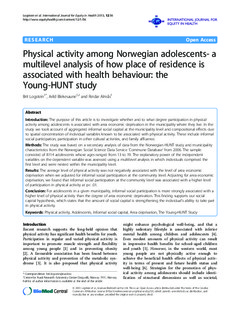| dc.contributor.author | Logstein, Brit | |
| dc.contributor.author | Blekesaune, Arild | |
| dc.contributor.author | Almås, Reidar | |
| dc.date.accessioned | 2019-10-25T09:02:36Z | |
| dc.date.available | 2019-10-25T09:02:36Z | |
| dc.date.created | 2013-08-05T12:08:48Z | |
| dc.date.issued | 2013 | |
| dc.identifier.citation | International Journal for Equity in Health. 2013, 12 (56), . | nb_NO |
| dc.identifier.issn | 1475-9276 | |
| dc.identifier.uri | http://hdl.handle.net/11250/2624388 | |
| dc.description.abstract | Introduction
The purpose of this article is to investigate whether and to what degree participation in physical activity among adolescents is associated with area economic deprivation in the municipality where they live. In the study we took account of aggregated informal social capital at the municipality level and compositional effects due to spatial concentration of individual variables known to be associated with physical activity. These include informal social participation, participation in other cultural activities, and family affluence.
Methods
The study was based on a secondary analysis of data from the Norwegian HUNT study and municipality characteristics from the Norwegian Social Science Data Service ‘Commune Database’ from 2006. The sample consisted of 8114 adolescents whose ages ranged from 13 to 19. The explanatory power of the independent variables on the dependent variable was assessed using a multilevel analysis in which individuals comprised the first level and were nested within the municipality level.
Results
The average level of physical activity was not negatively associated with the level of area economic deprivation when we adjusted for informal social participation at the community level. Adjusting for area economic deprivation, we found that informal social participation at the community level was associated with a higher level of participation in physical activity at p< .01.
Conclusion
For adolescents in a given municipality, informal social participation is more strongly associated with a higher level of physical activity than the degree of area economic deprivation. This finding supports our social capital hypothesis, which states that the amount of social capital is strengthening the individual’s ability to take part in physical activity. | nb_NO |
| dc.language.iso | eng | nb_NO |
| dc.publisher | BMC (part of Springer Nature) | nb_NO |
| dc.rights | Navngivelse 4.0 Internasjonal | * |
| dc.rights.uri | http://creativecommons.org/licenses/by/4.0/deed.no | * |
| dc.title | Physical activity among Norwegian adolescents- a multilevel analysis of how place of residence is associated with health behaviour: the Young-HUNT study | nb_NO |
| dc.type | Journal article | nb_NO |
| dc.type | Peer reviewed | nb_NO |
| dc.description.version | publishedVersion | nb_NO |
| dc.source.pagenumber | 10 | nb_NO |
| dc.source.volume | 12 | nb_NO |
| dc.source.journal | International Journal for Equity in Health | nb_NO |
| dc.source.issue | 56 | nb_NO |
| dc.identifier.doi | 10.1186/1475-9276-12-56 | |
| dc.identifier.cristin | 1041573 | |
| dc.description.localcode | © 2013 Logstein et al.; licensee BioMed Central Ltd. This is an Open Access article distributed under the terms of the Creative Commons Attribution License (http://creativecommons.org/licenses/by/2.0), which permits unrestricted use, distribution, and reproduction in any medium, provided the original work is properly cited. | nb_NO |
| cristin.unitcode | 194,67,25,0 | |
| cristin.unitname | Institutt for sosiologi og statsvitenskap | |
| cristin.ispublished | true | |
| cristin.fulltext | original | |
| cristin.qualitycode | 1 | |

